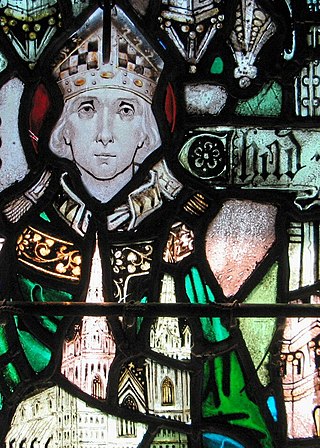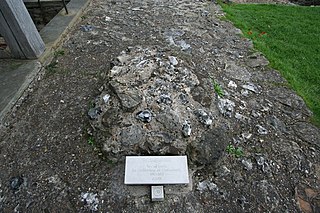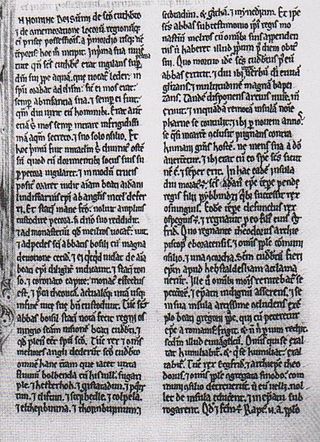Related Research Articles
{{Dec adebox|68}} The 680s decade ran from January 1, 680, to December 31, 689.

Cuthbert of Lindisfarne was an Anglo-Saxon saint of the early Northumbrian church in the Celtic tradition. He was a monk, bishop and hermit, associated with the monasteries of Melrose and Lindisfarne in the Kingdom of Northumbria, today in north-eastern England and south-eastern Scotland. Both during his life and after his death, he became a popular medieval saint of Northern England, with a cult centred on his tomb at Durham Cathedral. Cuthbert is regarded as the patron saint of Northumbria. His feast days are 20 March and 4 September.
Oswiu, also known as Oswy or Oswig, was King of Bernicia from 642 and of Northumbria from 654 until his death. He is notable for his role at the Synod of Whitby in 664, which ultimately brought the church in Northumbria into conformity with the wider Catholic Church.
Wilfrid was an English bishop and saint. Born a Northumbrian noble, he entered religious life as a teenager and studied at Lindisfarne, at Canterbury, in Francia, and at Rome; he returned to Northumbria in about 660, and became the abbot of a newly founded monastery at Ripon. In 664 Wilfrid acted as spokesman for the Roman position at the Synod of Whitby, and became famous for his speech advocating that the Roman method for calculating the date of Easter should be adopted. His success prompted the king's son, Alhfrith, to appoint him Bishop of Northumbria. Wilfrid chose to be consecrated in Gaul because of the lack of what he considered to be validly consecrated bishops in England at that time. During Wilfrid's absence Alhfrith seems to have led an unsuccessful revolt against his father, Oswiu, leaving a question mark over Wilfrid's appointment as bishop. Before Wilfrid's return Oswiu had appointed Ceadda in his place, resulting in Wilfrid's retirement to Ripon for a few years following his arrival back in Northumbria.
Ecgfrith was the King of Deira from 664 until 670, and then King of Northumbria from 670 until his death in 20 May 685 possibly at age of 31. He ruled over Northumbria when it was at the height of its power, but his reign ended with a disastrous defeat at the Battle of Nechtansmere against the Picts of Fortriu in which he lost his life.

Hexham Abbey is a Grade I listed church dedicated to St Andrew, in the town of Hexham, Northumberland, in the North East of England. Originally built in AD 674, the Abbey was built up during the 12th century into its current form, with additions around the turn of the 20th century. Since the Dissolution of the Monasteries in 1537, the Abbey has been the parish church of Hexham. In 2014 the Abbey regained ownership of its former monastic buildings, which had been used as Hexham magistrates' court, and subsequently developed them into a permanent exhibition and visitor centre, telling the story of the Abbey's history.

Chad was a prominent 7th-century Anglo-Saxon Catholic monk who became abbot of several monasteries, Bishop of the Northumbrians and subsequently Bishop of the Mercians and Lindsey People. He was later canonised as a saint.

Aldfrith was king of Northumbria from 685 until his death. He is described by early writers such as Bede, Alcuin and Stephen of Ripon as a man of great learning. Some of his works and some letters written to him survive. His reign was relatively peaceful, marred only by disputes with Bishop Wilfrid, a major figure in the early Northumbrian church.
Finan of Lindisfarne, also known as Saint Finan, was an Irish monk, trained at Iona Abbey in Scotland, who became the second bishop of Lindisfarne from 651 until 661.

Eata, also known as Eata of Lindisfarne, was Bishop of Hexham from 678 until 681, and of then Bishop of Lindisfarne from before 681 until 685. He then was translated back to Hexham where he served until his death in 685 or 686. He was the first native of Northumbria to occupy the bishopric of Lindisfarne.
Trumbert was a monk of Jarrow, a disciple of Chad and later Bishop of Hexham.

The Bishop of Hexham was an episcopal title which took its name after the market town of Hexham in Northumberland, England. The title was first used by the Anglo-Saxons in the 7th and 9th centuries, and then by the Roman Catholic Church since the 19th century.
Bosa was an Anglo-Saxon Bishop of York during the 7th and early 8th centuries. He was educated at Whitby Abbey, where he became a monk. Following Wilfrid's removal from York in 678 the diocese was divided into three, leaving a greatly reduced see of York, to which Bosa was appointed bishop. He was himself removed in 687 and replaced by Wilfrid, but in 691 Wilfrid was once more ejected and Bosa returned to the see. He died in about 705, and subsequently appears as a saint in an 8th-century liturgical calendar.
Trumwine was the only ever Bishop of the Northumbrian see of the Picts, based at Abercorn.
The Council of Hertford was the first general council of the Anglo-Saxon Church. It was convened in Anglo-Saxon Herutford, most likely modern Hertford, in 672 by Theodore of Tarsus, Archbishop of Canterbury. The Venerable Bede is the historical source for this council, as he included its text in his Ecclesiastical History of the English People.
Events from the 8th century in England.

Events from the 7th century in England.

The Historia de Sancto Cuthberto is a historical compilation finished some time after 1031. It is an account of the history of the bishopric of St Cuthbert—based successively at Lindisfarne, Norham, Chester-le-Street and finally Durham—from the life of St Cuthbert himself onwards. The latest event documented is a grant by King Cnut, c. 1031. The work is a cartulary chronicle recording grants and losses of property as well as miracles of retribution, under a loose narrative of temporal progression. The text survives in three manuscripts, the earliest of which dates from around 1100. The original version of the text is not thought to be extant; rather, all surviving manuscripts are thought to be copies of an earlier but lost exemplar. The Historia is one of the sources for the histories produced at Durham in the early 12th century, particularly the Historia Regum and Symeon of Durham's Libellus de Exordio.
The Vita Sancti Cuthberti is a prose hagiography from early medieval Northumbria. It is probably the earliest extant saint's life from Anglo-Saxon England, and is an account of the life and miracles of Cuthbert, a Bernician hermit-monk who became bishop of Lindisfarne. Surviving in eight manuscripts from Continental Europe, it was not as well read in the Middle Ages as the prose version by Bede. It was however Bede's main source for his two dedicated works on Cuthbert, the "Metrical Life" and the "Prose Life".
Alfred, son of Westou was a medieval English priest and relic collector, active in Northumberland. He is now best known for allegedly stealing the remains of Bede and bringing them in secret to the shrine of St Cuthbert in Durham, although some modern scholars consider this unlikely. He is also documented as having translated the remains of Boisil of Melrose Abbey, as well as numerous northern English minor saints of the 7th and 8th centuries: the anchorites Balther and Bilfrid; Acca, Alchmund and Eata, bishops of Hexham; Oswin, king of Deira; and the abbesses Ebba and Æthelgitha. He served as the sacristan at Cuthbert's shrine under three bishops, and was renowned for his devotion to the saint.
References
- Bede (1991). D.H. Farmer (ed.). Ecclesiastical History of the English People . Translated by Leo Sherley-Price. Revised by R.E. Latham. London: Penguin. ISBN 0-14-044565-X.